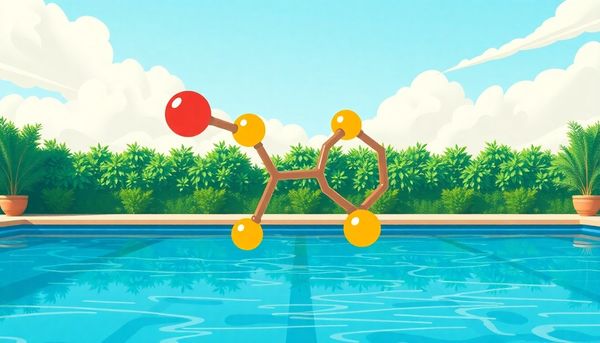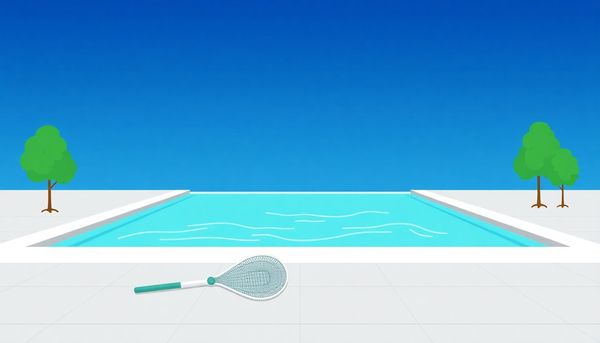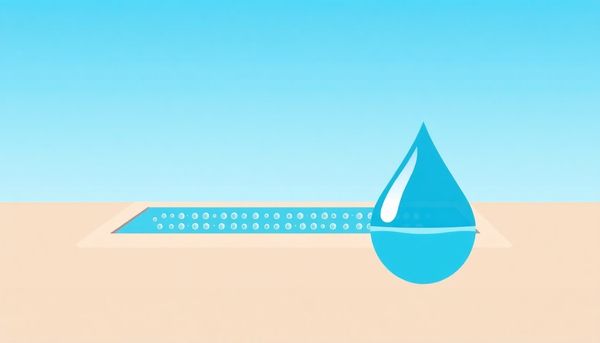Understanding Nitrates: The Key to Crystal-Clear Pool Water
April 21th, 2024
April 21th, 2024
Under the shimmering surface of a pool lies a fascinating world of chemistry that many overlook. Long summer days spent poolside are cherished by families everywhere, yet few ponder the science maintaining that crystal-clear water. Among the many elements at work, nitrates play a crucial—though often misunderstood—role. I recall an afternoon chat with my neighbor, a fellow pool enthusiast, who shared tales of persistent murkiness despite diligent maintenance. This led me on a quest to understand the hidden impacts of nitrates in pool water.
Nitrates, naturally occurring compounds found in soil and water, are notorious for their potential to disrupt your pool's delicate balance. Factors such as rainwater, fertilizers, and even bodily residues from swimmers contribute to their accumulation. Unlike other pollutants, nitrates are sneaky; they don't directly harm swimmers but can fuel unwanted algae blooms, turning your oasis into a green nightmare.
The truth about nitrates is not just a scientific curiosity; it's a practical concern for every pool owner. By harnessing this knowledge, you can maintain the inviting, safe haven you envision for your family and friends. So, how do we navigate this complex issue? Understanding the nuances of nitrate management can transform your approach to pool care, ensuring those sunny afternoons remain uninterrupted by unexpected challenges.

No one wants a murky pool as a backdrop to their afternoon swim. Yet, the reality of nitrates lurking in pool water can seem daunting. Instead of reaching for drastic measures like draining and scrubbing, consider a more thoughtful approach. Understanding nitrates and their sources is the first step in combating contamination effectively.
Consider rural settings. If you live near farmland, water runoff might carry nitrates from fertilizers or animal waste straight into your pool. A simple preventive solution? Enhance your yard’s drainage or create a small barrier to direct runoff away. If your water source comes from a well, testing regularly is crucial, as wells are notorious nitrate carriers.
Urban or suburban dwellers face their own challenges. Rain can wash nitrates from lawn treatments into your pool. Keeping your pool covered during storms can help mitigate this. Similarly, our furry friends, with their love for romping through grass and rolling in dirt, can inadvertently introduce nitrates. Rinsing them off before they take a dip would keep things in check.
Remember, battling contamination doesn't mean banishing every nitrate particle. Instead, focus on maintaining a healthy, sanitized environment that prevents algae from thriving. Regular cleaning and water testing keep your pool pristine, turning nitrate worries into a thing of the past. Dive into the joy of a well-maintained pool without the nitrate nightmare.
Algae growth can feel like an unwelcome guest at a pool party, and nobody wants that. While nitrates do serve as a feast for algae, the real trick lies not in waging war against nitrates themselves, but in turning your pool into a hostile environment for algae growth. This means maintaining a regular cleaning and sanitizing routine that keeps unwanted flora at bay.
Think of your pool like a cherished pet. It needs care and attention to flourish. Consistent water testing is crucial to ensure chlorine or other sanitizers are at optimal levels. I once got too relaxed with my pool maintenance, thinking the water looked clear enough. Two weeks later, I was greeted by a bloom of algae, turning my oasis a murky green. Lesson learned: regular shocking and scrubbing are non-negotiable.
In addition to maintaining sanitizer levels, consider investing in a reliable pool cover. It’s a small step that shields your water from debris and contaminants like rain, which can introduce nitrates. My friend swears by her automatic pool cover; she claims it’s saved her countless hours of cleaning.
Ultimately, algae prevention is a proactive game. Keep your pool's defenses strong, and you’ll find that nitrates aren’t the menace they’re often made out to be. Embrace routine maintenance, and your pool will remain a sparkling retreat, free from the clutches of invasive algae.
Unraveling the mystery of nitrate sources in your pool is akin to embarking on a detective mission in your own backyard. Look around, and you'll find that these tiny compounds sneak in from unexpected places. Fertilizers are a prime suspect, especially if your garden resembles a lush oasis. While they work wonders on your roses, that same nitrate boost can make its way into your pool with a little help from wind or rain.
In the countryside, the plot thickens. Living near cattle grazing lands or relying on well water might be adding extra nitrates to your pool. Agricultural runoff is notorious for carrying nitrates far and wide, and if your water source isn't scrutinized, you could be inviting them in with every refill.
Septic systems provide yet another twist. Homes not connected to municipal wastewater systems may experience seepage from septic tanks, slyly introducing nitrates into the pool. Even the family pooch can play a role in this saga. Those playful swims after a romp in the garden can bring nitrates clinging to their fur straight into the water.
Birds, seemingly innocent with their aerial grace, can drop a nitrate bombshell with each visit. Their droppings are rich in the compound, adding to the nitrate load. Understanding these sources empowers you to keep your pool pristine, focusing on balanced maintenance rather than chasing an elusive complete nitrate removal.
Stepping into the world of pool maintenance, you'll soon discover that maintaining proper sanitizer levels is akin to being a diligent gatekeeper. It’s not just about keeping your pool pristine; it's about creating an environment where algae, fueled by pesky nitrates, have no chance to crash the party. Picture your sanitizer as an invisible shield, tirelessly working to fend off unwanted invaders.
Start by ensuring your pool's water chemistry is balanced. Regular testing is crucial, much like checking the oil in your car. Each week, take a few moments to dip those test strips and assess the levels. Adjust as needed, ensuring your chlorine or alternative sanitizer remains within its optimal range. Never underestimate the power of routine. Just as you wouldn’t skip brushing your teeth, avoid skipping pool shocks. Weekly shocks help maintain sanitizer efficacy by eliminating organic contaminants that feed on sanitizer levels.
Consider investing in an automatic chlorinator or a saltwater chlorination system. A friend of mine swears by her saltwater system for its ease of use and consistent results. But whatever system you choose, the key is consistency and vigilance.
By maintaining proper sanitizer levels, you’re not just keeping your pool clean—you’re ensuring it remains a place of relaxation rather than frustration. Embrace this approach, and those nitrates will become a distant concern, leaving you to enjoy your sparkling oasis.

Nitrates in your pool might seem like a mystery, but unraveling their sources is simpler than you think. They often originate from everyday elements in our lives, merging into the water unnoticed. In rural settings, water runoff is a usual suspect, especially near farmland or grazing areas where fertilizers and animal waste contribute significantly. If your property relies on a septic system, nitrates might be quietly seeping into the ground, eventually winding up in your pool.
Even urban dwellers aren't exempt. For those using well water, the risk of high nitrate content is real. Monitoring your water source is crucial, as these compounds can sneak in at the very start of your pool-filling process. Meanwhile, your carefully tended garden might be more than a visual delight. The fertilizers that help your lawn thrive could be adding to the nitrate load, particularly after a heavy rainstorm carries runoff to your pool.
Think about those summer rain showers. They don't just refresh the air; they can also wash nitrates from the atmosphere into your pool, transforming your oasis into an unexpected garden bed for algae. Pets, too, play their part, with dogs happily splashing in, carrying nitrates on their paws and fur. By understanding these sources, you can better manage the balance in your pool, ensuring it's a place of relaxation, not a breeding ground for unwanted growth.
Understanding the culprits behind nitrate levels in your pool can be like unraveling a mystery. One might not immediately suspect that the very elements contributing to the lushness of your backyard could be at fault. Fertilizers are prime offenders; they sneak into your pool via runoff, especially after a heavy rain. Imagine your beautiful garden unwittingly plotting against your pool's clarity.
In the countryside, the adventure takes a different turn. Water runoff from nearby farms, where cattle graze contentedly, can introduce nitrates into your pool. Living close to agricultural areas means your pool could be catching more than just sunshine. For those with septic tanks, the story gets even trickier. Poorly maintained tanks can leach nitrates into the surrounding soil, which eventually finds its way to your pool.
Animals bring another twist to this tale. Your furry friends, especially dogs, might love a good swim, but they also carry nitrates on their paws and fur. Wild visitors like birds and ducks are not just passing guests; their droppings can pack a nitrate punch. Even humans contribute, albeit unwittingly, through sweat and personal care products.
Keeping your pool clear isn't about waging war on nitrates, but more about understanding where they come from and ensuring your pool remains a sanctuary of relaxation rather than a battleground.
Rural landscapes, with their picturesque charm, often harbor invisible guests that sneak into your backyard oasis. Nestled amid rolling hills and expansive fields, the allure of country living can also introduce an unexpected villain to your pool: nitrate-laden runoff. When springtime melts into summer, rains can sweep across these pastoral scenes, gathering nitrates from fertilizers and animal waste. This nutrient-rich concoction can then flow into nearby water bodies, including your unsuspecting pool.
Consider my neighbor, who found her idyllic farm life quietly contributing to a mysterious algae bloom. Her pool, previously a crystal gem, turned murky green overnight. The culprit? Runoff from her own fertilized vegetable patch. This phenomenon isn’t isolated; in fact, it’s a common tale in rural areas. Homes relying on septic systems may inadvertently leak nitrates into the surrounding soil, which, with a little help from rain, finds its way into pools.
Wells, too, can be a sneaky source of nitrates, especially if they draw from groundwater affected by nearby agricultural activities. As water cycles through this nutrient-rich environment, it carries these nitrates right into your pool. The solution isn’t to drain and scrub your pool into submission but to outsmart the nitrates by maintaining rigorous water treatment and sanitation routines. Keep the nitrates at bay by ensuring your pool remains a sanctuary for swimmers, not algae.
Wildlife has an uncanny knack for finding its way into pools, transforming serene backyard sanctuaries into unwitting sites of contamination. One sunny afternoon, I noticed an unexpected guest—a duck—taking a leisurely dip in my pool. Harmless as it seemed, this visitor and its feathered friends can deposit nitrates, especially through droppings, introducing the very elements that feed pesky algae.
To shield your pool from such invaders, a few proactive measures can make all the difference. Investing in a pool cover not only keeps debris at bay but also deters wildlife from making a splash. If a cover seems cumbersome, utilizing floating objects like inflatable alligators or owls can trick birds into believing predators are near, thus discouraging them from landing.
Gardens and lawns benefit from nutrients, but runoff from fertilizers can be a nitrate highway into your pool. Creating buffer zones with mulch or stones can intercept these chemical travelers. It’s akin to setting up a defensive line, ensuring your pool remains pristine.
Consider your four-legged companions, too. Dogs love a swim, but they also love romping through the grass, gathering nitrates as they go. Rinsing their paws and fur before they join you in the pool can significantly reduce this form of contamination.
Ultimately, by taking a few mindful steps, you can enjoy your pool while minimizing its role as a nitrate haven for wildlife.
The battle against algae in your pool doesn’t have to be a never-ending saga. Instead of exhausting yourself with nitrate removal, channel your energy into consistent pool maintenance. Maintaining a pristine pool begins with regular cleaning and vigilant water testing. These steps ensure that your pool is less inviting to algae, which feeds on nitrates.
Consider this—chlorine, your trusty ally, thrives as the defender of your pool. Regularly check that its levels are within the recommended range. This isn’t just about keeping your water clear but also about establishing a hostile environment for algae. Weekly pool shocking is another effective method. The shock treatment acts like a reset button, eliminating any early-stage algae growth before it becomes a full-blown infestation.
The beauty of this approach lies in its simplicity. My neighbor, for example, used to fret constantly about nitrates, battling algae blooms every summer. Once they shifted focus to a regular sanitation schedule, the transformation was remarkable. Their pool became a sparkling oasis, free from the green menace.
By prioritizing cleanliness and routine maintenance, you can enjoy a pool that’s always ready for a swim. Forget chasing elusive nitrate levels. Instead, embrace a straightforward plan that keeps algae at bay, letting you savor those sunny days without worry.
A pool, a bastion of relaxation and leisure, can quietly turn into a breeding ground for nitrates if one isn't vigilant. Nitrates, those sneaky compounds, have a knack for creeping into your oasis through a variety of unassuming sources. Growing up in a house surrounded by lush lawns and gardens, I remember my parents’ constant battle with pool maintenance. Our backyard was a paradise for nature, which meant it was also an unwitting source of nitrates.
Fertilizers, the very substance that keeps your garden vibrant, are a primary suspect. When they wash off into the pool, they bring nitrates along for the ride. Living near farmland, or having a septic tank, adds another layer of complexity, as runoff from these can also infiltrate your pool. Rainfall, often a welcome respite in the summer heat, isn’t innocent either. It can carry nitrates from your yard into your pool if uncovered during a storm.
Then, there’s local fauna. Birds, ducks, and pets, while delightful in their natural habitat, can be culprits. I recall our golden retriever, Max, who loved splashing around in the pool, unknowingly introducing nitrates with every wag of his tail. Human activities, too, contribute; lotions, sweat, and even the residue from your morning coffee can gradually build up nitrate levels.
Understanding these pathways is crucial, not just for maintaining crystal-clear water, but for ensuring your summer afternoons are spent enjoying the pool, not scrubbing it.
Keeping your pool’s sanitizer levels in check is the unsung hero of effective pool maintenance. While many might rush to drastic measures to combat nitrates, maintaining proper sanitizer levels is a more sustainable approach. It’s like having a reliable friend who quietly ensures everything stays in balance, keeping algae at bay despite the presence of nitrates.
Each week, dedicate a moment to test the water. Testing kits are widely available and easy to use. They will help you keep an eye on chlorine or other sanitizers you might be using. This small step can make a significant difference, ensuring your pool remains a safe haven for fun, rather than a breeding ground for algae.
Consider how you prepare for a dinner party. You might clean the house, set the table, and choose the right music to create a welcoming atmosphere. Similarly, regular pool shocking acts as that extra polish, effectively eliminating any lurking contaminants. It’s not just about cleanliness, but peace of mind knowing the environment you’ve created is healthy and inviting.
By incorporating these practices into your routine, you’ll find maintaining your pool becomes less of a chore and more of a seamless part of your lifestyle. Remember, the goal isn't to wage war against every nitrate but to ensure your pool remains a sparkling retreat. Enjoy the refreshing splash, knowing your efforts help keep it pristine.
A steaming cup of coffee and a brisk morning breeze by the pool—sounds idyllic, doesn’t it? Yet the serenity shatters with the sight of green-tinted water, an unmistakable sign of algae. And lurking beneath the surface is the less visible culprit: nitrates. While eradicating every speck of nitrate is a pipe dream, maintaining a clear pool is possible through the art of regular pool shocking.
Shocking the pool, a process that involves adding a potent dose of chlorine or other oxidizing agents, serves as a robust line of defense against algae. This practice not only obliterates organic contaminants and harmful bacteria but also targets the very environment that allows algae to thrive. When nitrates provide a feast for algae, shocking acts like an unexpected guest, disrupting their party before it even starts.
Consider this akin to spring cleaning for your pool water. A weekly routine of pool shocking can effectively curb algae growth by ensuring that the sanitizer levels remain optimal. Picture a family barbecue, where each guest brings a dish and the host keeps things running smoothly. Here, you’re the host, and your pool is the party. Regular shocking keeps those unwelcome guests (algae) from crashing.
In essence, the secret isn’t banishing nitrates; it’s about maintaining the balance that keeps your pool inviting and clean. Embrace regular shocking, and let your pool remain a refreshing oasis, not a battleground for unwanted organisms. So, grab your favorite pool float and enjoy the peace that comes with a well-maintained swim space.

When it comes to maintaining clean water in your pool, clarity is not just a visual appeal; it’s the backbone of a healthy swimming environment. My neighbor once had a pool that was more swamp than sanctuary, all because of neglecting simple water maintenance rituals. The secret to avoiding such a fate? Consistency in care.
Begin by ensuring your pool is adequately covered when not in use. This simple step can drastically reduce the amount of organic debris and nitrates, like those from rain or bird droppings, making their unwelcome entrance. Just imagine the relief of uncovering a pristine pool after a storm!
Regular testing is another indispensable practice. Invest in a reliable kit to check for sanitizer levels, pH, and alkalinity at least once a week. If your pool is exposed to factors like fertilizer runoff or pets, increase the frequency. This proactive approach helps you catch any imbalance before it spirals out of control.
Don’t forget the power of shocking your pool. A weekly shock treatment keeps algae at bay by eliminating contaminants that typical sanitizers might miss. It’s akin to giving your pool a fresh start every week.
By integrating these steps into your routine, you safeguard your backyard oasis against the invisible threats posed by nitrates. Keeping your pool clean is less about battling the elements and more about embracing a rhythm of regular care.
Nitrate management in your pool often feels like battling invisible adversaries, but understanding their sources is your best defense. Begin by examining your surroundings. Living in rural areas often means dealing with runoff from nearby farms. Fertilizers and manure, rich in nitrates, can easily wash into your pool after a good rain. Those living in regions reliant on well water should be particularly vigilant; wells can harbor significant nitrate levels, sneaking into your pool with each top-up.
Then there's your own backyard. Fertilizers do wonders for your lawn, but when rain sweeps across your garden, it might carry those nitrates right into your pool. Even more surprising are the small, everyday contributions. Pets frolicking in the grass or wildlife visiting your oasis contribute with their own little nitrate deposits. Ducks, birds, and even your beloved furry friends can inadvertently introduce nitrates via their fur and feathers as they enjoy a swim.
Human activity also plays its part. Every sunscreen application or splash of sweat adds a fraction more to the nitrate total. Over time, these small contributions build up, providing a veritable feast for algae.
The goal isn't to eliminate nitrates but to control them by minimizing their entry. Consider using covers during rainstorms, ensuring pet paws are rinsed before a swim, and maintaining a vigilant eye on your pool's environment. By managing these sources, keeping algae at bay becomes a much simpler task.
Nitrates in your pool might sound like a lurking menace, waiting to turn your sparkling oasis into a murky swamp. Yet, tackling this issue doesn’t require a chemistry degree or hours of labor. Instead, the focus should be on preventing algae from setting up camp in the first place. Imagine you’re hosting a party; you wouldn’t throw out all the food just because a few uninvited guests might show up. Similarly, eliminating nitrates isn’t the goal. Rather, the key lies in maintaining a clean and sanitized pool environment.
Regular pool maintenance acts as your main line of defense. Sticking to a consistent cleaning schedule can thwart the growth of algae before it even begins. Testing the water often ensures that your sanitizer levels are optimal. Whether you rely on chlorine or another sanitizer, keeping it at the right level is crucial. Weekly shocking of the pool also keeps unwanted algae guests at bay.
Taking these steps not only simplifies pool care but allows you to focus on the joy of swimming. The presence of nitrates becomes insignificant if algae cannot thrive. So, dedicate your efforts to creating a hostile environment for algae, not stressing about nitrate levels. With vigilance and routine care, your pool remains an inviting retreat, free from unwanted algae bloom drama. Here's to clear waters and carefree swims!
A sparkling pool is more than just a luxury; it's a small oasis in your backyard. However, the tranquility can quickly turn murky if proper sanitation isn't maintained. Consider the routine of a dedicated pool owner I know—every morning, armed with a trusty test kit, he checks the chemical levels with the precision of a scientist. This simple yet crucial task ensures that the chlorine levels are optimal, keeping harmful bacteria and algae at bay. It's not just about adding chemicals; it's about understanding the delicate balance required to maintain a healthy aquatic environment.
Each week, he makes it a point to shock the pool, a process that involves adding a concentrated dose of chlorine to eradicate any lurking contaminants. This regular maintenance disrupts the cycle of algae and bacteria before they have a chance to establish themselves. Missing this step, as he once did during a busy summer, resulted in a greenish tinge that required days of effort to clear up.
Moreover, everyday habits like rinsing off before diving in can significantly reduce the influx of oils and residues that contribute to nitrate buildup. Imagine sunscreen, lotions, and even perfumes mingling with the pool water, slowly skewing its chemistry. By keeping these practices in check, nitrates become a manageable factor, rather than a daunting enemy. Remember, a little diligence can transform pool care from a chore into a habit, leaving you with more time to enjoy the refreshing escape just outside your door.

Think of your pool as a mini-ecosystem, where keeping balance is key. While the idea of completely eradicating nitrates might seem appealing, it’s not only impractical but unnecessary. Instead, prioritize pool sanitization. When my neighbor, Bob, faced an algae bloom last summer, it wasn’t because he didn’t battle nitrates; it was because he neglected regular maintenance. Bob’s story highlights an important truth: preventing algae is less about eliminating nitrates and more about maintaining proper sanitation.
Start with a solid routine. Regular water testing is your first line of defense. It might sound tedious, but it’s akin to checking a car’s oil level; a minor effort that prevents major headaches. Keep your sanitizer levels, like chlorine, within the recommended range. This simple step creates an inhospitable environment for algae, which rely on nutrients like nitrates to thrive.
Shocking your pool weekly is another effective strategy. This isn’t just about killing bacteria; it’s about controlling organic contaminants before they can fuel algae growth. Remember, a clean pool doesn’t happen by accident—it’s the result of consistent, proactive care.
Ultimately, the focus should be on enjoying your pool, not fretting over nitrates. Invest effort in regular sanitization, and you’ll spend more time floating worry-free in crystal-clear water, rather than battling unnecessary nitrate paranoia.
A lazy afternoon by the pool shouldn't be soured by pesky algae blooms. While nitrates are part of the picture, the secret to a crystal-clear pool lies not in battling these invisible invaders, but in preventing algae from setting up camp in the first place. My own pool routine revolves around a few simple, natural strategies that keep the water sparkling and inviting.
First, embrace the power of plants. Surrounding your pool with native, non-invasive plant species can naturally absorb excess nitrates before they reach the water. It's like having a little army of guardians shielding your pool from unwanted guests. In my backyard, a row of vibrant ferns not only adds to the aesthetic but also plays this crucial role.
Next, befriend barley straw. This might sound like an old wives' tale, but placing small bales of barley straw in the water can inhibit algae growth. As the straw decomposes, it releases compounds that gently prevent algae from taking hold. A neighbor swears by this method, and it’s become a quirky topic of conversation during neighborhood barbecues.
Finally, let the sun do some heavy lifting. Regularly exposing your pool to direct sunlight can deter algae, as these organisms thrive in shaded, stagnant water. By trimming back overhanging branches, you're not only brightening up the area but also naturally keeping algae at bay.
Incorporating these natural strategies can transform your pool care routine into a more sustainable, hassle-free endeavor. With a bit of creativity and a touch of nature, those algae woes will be a thing of the past, allowing you to focus on enjoying endless swims under a clear blue sky.
Managing water sources effectively is akin to being a detective in your own backyard. It's about tracing every drop that finds its way to your pool, ensuring that it remains a sanctuary of clear, inviting water. For instance, if your property relies on a well, it's crucial to test the water regularly for nitrates. Wells often harbor higher nitrate levels, especially in agricultural areas. By investing in a simple water testing kit, you can ensure your water source isn't contributing to potential nitrate build-up.
The geography of your yard plays a significant role too. Consider the slope of your lawn and how rainfall might carry fertilizer-laden runoff straight into your pool. Installing a small drainage system or redesigning the landscape to divert water away can be a game-changer. I've seen a neighbor create a natural barrier with strategically placed shrubs, not only enhancing the garden's beauty but also preventing runoff.
Even the smallest gestures make a difference. Keeping pets and wildlife at bay might seem a fool's errand, but simple deterrents can help. A pool cover works wonders—especially during stormy weather—acting as a shield against nitrates delivered by rain or curious critters. Managing these sources isn't about eliminating nitrates completely but controlling their pathways and keeping that inviting splash zone just as it should be.

This article provided insights into maintaining your pool. Start your pool care journey today!
Want to become a pool maintenance expert? Our free Pool School course covers everything you need to know about pool care. From basic maintenance to advanced troubleshooting, you'll learn how to:
Join over 10,000 pool owners who have already transformed their pool care routine. Get started with our free Pool School course today!